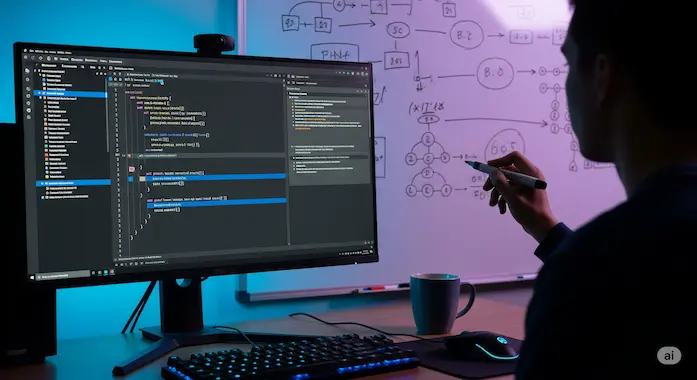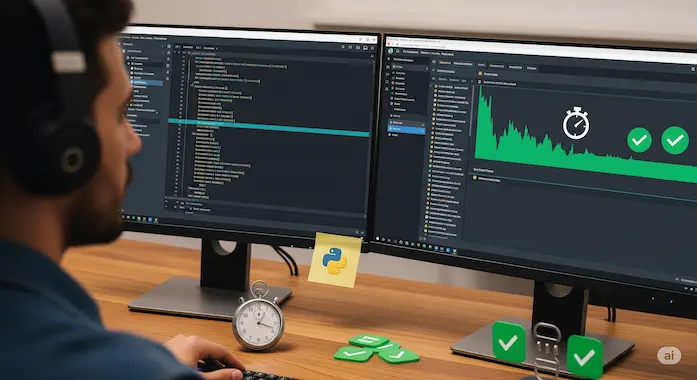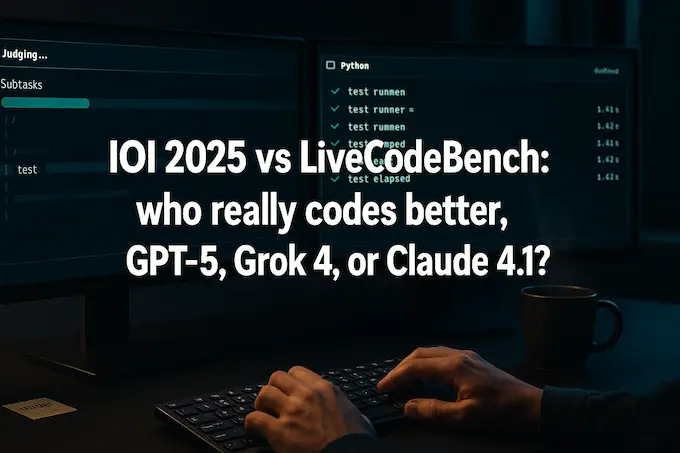Introduction
Launch decks are fun. They sparkle, then fade. Real work starts when a model lands in an editor and meets a deadline. That is where a lot of the glossy claims fall apart. Developers do not need another victory lap. They need an answer to a blunt question. Which systems write code that runs, and which ones only write code that looks like it runs. This piece is a field guide to the best llm for coding 2025, built from two complementary sources of truth.
Two evaluation families now set the pace. One channels the International Olympiad in Informatics, the IOI benchmark. Think ruthless algorithmic puzzles and an automated grader that takes no excuses. The other is a rolling, never sleepy suite called the LiveCodeBench benchmark. It keeps shuffling in fresh problems from LeetCode, AtCoder, and Codeforces, then verifies functional correctness with hidden tests.
Read both and a useful split emerges. On the algorithmic gauntlet, Grok 4 pulls ahead. On the practical Python feed, GPT-5 Mini steals the show. That is not a contradiction. It is a map. It tells you what each lab optimized for, which is the only way to answer the question that matters, what is the best llm for coding 2025 for your team.
Table of Contents
1. What the IOI Benchmark Is Actually Testing

The IOI is not about wiring views or calling SaaS APIs. It is a pressure test for reasoning. Graphs, dynamic programming, combinatorics. Problems that punish sloppy thinking. To translate that spirit to machines, the Vals AI team built an agent harness with a modern C++20 toolchain and a submission server that mirrors the contest grader. The agent can compile, run, submit, and collect partial credit on subtasks up to a budget. That loop rewards planning and repair, not copy paste. It probes depth in a way standard single pass prompts rarely do.
If you want context for the contest that inspired the test, browse the official IOI resources and past tasks. The culture around rigorous automated judging is why the setup translates cleanly to code agents.
2. What the LiveCodeBench Benchmark Measures

Daily engineering is not an olympiad. It is a conveyor belt of medium difficulty tickets. LiveCodeBench models that cadence. It continuously pulls new problems from interview grade sources, asks for a Python solution, and checks against hidden tests. The design fights data contamination and keeps pressure on functional correctness. The research paper adds richer scenarios like test output prediction and self repair, which gives a broader signal than single pass code generation. On the August leaderboard, GPT-5 Mini leads, followed by o3, then Grok 4, with o4 Mini close behind. For a developer workflow, that ordering matters as much as raw accuracy because it tracks how fast the loop feels.
3. Results at a Glance
The table below merges the headline numbers so you can see IOI 2025 and LiveCodeBench side by side. Accuracy comes from each benchmark snapshot in early August. Cost entries are API list prices per one million input and output tokens. Latency is the average reported by the LiveCodeBench run.
| Model | IOI 2025 accuracy | LiveCodeBench accuracy | Cost in / out | Avg latency |
|---|---|---|---|---|
| GPT-5 Mini | n/a | 86.6% | $0.05 / $0.40 | 33.67 s |
| o3 | n/a | 83.9% | $2.00 / $8.00 | 63.95 s |
| Grok 4 | 26.2% | 83.2% | $3.00 / $15.00 | 229.40 s |
| o4 Mini | 5.3% | 82.2% | $1.10 / $4.40 | 32.84 s |
| Gemini 2.5 Pro Preview | 17.1% (Pro) | 79.2% | $1.25 / $10.00 | 164.66 s |
| GPT-5 | 20.0% | 77.1% | $1.25 / $10.00 | 159.34 s |
| Qwen 3 (235B) | 0.0% | 70.6% | $0.22 / $0.88 | 429.48 s |
| Kimi K2 Instruct | 1.3% | 70.4% | $1.00 / $3.00 | 66.65 s |
| Claude Opus 4.1 | 15.2% | 64.6% | $15.00 / $75.00 | 32.51 s |
Numbers reflect the Vals snapshots dated August 11 and August 7. LiveCodeBench also maintains an open leaderboard and a paper that explains the data flow and scoring in detail. Together these are the best public windows into AI coding accuracy today.
4. Why the Leaderboards Disagree, and Why That Is Useful
The IOI benchmark uses C++ and an agent loop. The LiveCodeBench benchmark uses Python and a single pass solve. One measures a specialist. The other measures a generalist. IOI behaves like a lab test for algorithmic depth. LiveCodeBench behaves like a field test for ticket velocity. Different training priorities shine under each light.
Language matters too. C++ forces careful thought about types and memory. Python is looser, which suits interview style problems and glue work. That is one reason Grok 4, which leans into long chains of reasoning, looks stronger on IOI, while GPT-5 Mini, tuned for fast clean snippets, thrives on LiveCodeBench. If your goal is to choose the best llm for coding 2025 for a specific product, you need both pictures.
Workflow matters as well. IOI allows retries and partial credit. That rewards planning and repair. LiveCodeBench measures pass at one with hidden tests. That rewards clarity and precision. These are not footnotes. They determine how a model feels inside an IDE and how you design prompts.
5. Model Philosophies in Practice
Grok 4, the Deep Diver. When a problem is a puzzle with sharp edges, Grok 4 pushes further before it gives up. The downside is speed. On LiveCodeBench it still lands near the top, yet its average latency is several minutes, which can stall an inner loop. This tradeoff makes sense for research spikes or algorithm heavy tickets. It is not ideal for autocompleting unit tests. If algorithmic challenges live in your roadmap, anchor your llm coding comparison with Grok’s profile first.
GPT-5 and GPT-5 Mini, the Pragmatic Pair. The flagship posts solid numbers across both snapshots. The Mini variant leads LiveCodeBench on accuracy, speed, and price. That spread gives you a clean tuning knob across llm latency and cost. For a team that needs to control spend, GPT-5 Mini can carry most of the load, while the larger model handles the gnarly work. Vals lists both on the same board, which makes the difference visible even to non specialists.
Claude Opus 4.1, the Careful Editor. Anthropic’s system material reports strong results on SWE-bench Verified, a benchmark built from real GitHub issues. That is closer to enterprise maintenance than to olympiad puzzles. The price is high, which means you reserve it for sensitive refactors, multi file edits, or compliance heavy reviews. If your goal is fewer regressions, not seconds saved, Claude 4.1 coding remains a strong option, as it is designed to avoid common llm hallucinations.
o3 and o4 Mini, the Agile Operators. The o3 model is a top LiveCodeBench performer. The o4 Mini sits just behind it with near instant responses. Together they make a reliable pair when you want to keep everything in one provider and push on speed.
Gemini 2.5 Pro, the Broad Generalist. Google’s entrant trails the very top on both charts, yet it remains competitive on general programming work. The advantage shows up more in multi modal tasks and long context research, so it still deserves a slot in your toolbox.
6. Cost and Speed Are Product Features
Accuracy dominates headlines. Once a model sits in a pipeline, llm latency and cost matter just as much. A thirty second answer keeps a developer in flow. A four minute answer breaks the thread. Unit economics matter too. At scale, a single dollar per million tokens turns into a material budget line. The LiveCodeBench snapshot calls out these differences clearly, including a wide spread in latency between Grok 4 and the faster OpenAI models.
7. A Practical Build: The Tiered Model Stack

There is no single king model. There is a small crew that works well together. The table below maps tasks to a sensible default and a backup. Adjust the thresholds to match your repo size and your risk profile. This is the simplest way to build a stable assistant that earns trust over time.
| Task type | Default choice | Backup choice | Why this fit |
|---|---|---|---|
| Daily snippets and tests | GPT-5 Mini | o4 Mini | Fast responses and high pass rates on fresh LiveCodeBench problems keep the loop tight. |
| Algorithmic puzzles | Grok 4 | GPT-5 | Leads IOI style challenges and tolerates longer chains of thought and retries. |
| Large refactors | Claude Opus 4.1 | GPT-5 | Strong on repository sized edits and careful reasoning. Pricey, so use when risk is high. |
| Prototype endpoints | o3 | GPT-5 Mini | Good balance of accuracy and speed for quick API or data glue work. |
| Long context research | Gemini 2.5 Pro | Claude 4.1 | Broad knowledge and reliable summarization for RFCs and design docs. |
8. Prompt Design That Survives Production
Benchmarks do not include your prompt. Your prompt becomes the task surface. For LiveCodeBench style problems, keep instructions short and explicit. Ask for a single Python function with no extra logs. Include a tiny test harness and request only the function body. For IOI style work, use a two stage plan. First, ask for a step by step plan with estimated complexity. Second, ask for code that follows that plan. This is a core part of effective context engineering. This cuts down on flailing. It also narrows token use, which improves your llm latency and cost.
When you evaluate internally, mirror the public setups. For an IOI shaped ticket, give your agent a compiler and a budget of submissions. For a LiveCodeBench shaped task, measure pass at one with hidden tests and strict I O. This is how you keep your own llm coding comparison honest.
9. Where to Double-Click, With Deeper Reads
If you want to understand Grok’s long chain behavior, start with our review of the Heavy variant, then compare your notes with the IOI snapshot. The contrast helps you decide when to escalate to Grok during a sprint. For a clean overview of the new OpenAI family, read our GPT-5 benchmarks explainer and the hands on GPT-5 guide, then plug those notes into the LiveCodeBench picture. When you need a sober view on safety and edit quality, study Claude 4.1’s system material and pair it with a SWE-bench verified workflow.
9. Caveats Worth Keeping
A benchmark snapshot is not a contract. Providers tune models over weeks, and small prompt changes move needles. IOI uses C++ with an agent harness. LiveCodeBench uses Python without tools. That means both miss entire classes of professional tasks like shelling out to linters, writing migrations, or editing a frontend tree with a layout constraint. Use both as reliable street signs, much like our own AI IQ Test.
The model market also changes fast. A new preview can land on a Thursday and reshuffle a chart by Monday. Track the official pages and the public leaderboards, not screenshots ripped out of context. Then rerun your own tests on your own code. That is the only result that matters for your users.
10. So, Which Is the Best LLM for Coding 2025?
Reach for GPT-5 Mini first. Call Grok 4 when a ticket turns into a puzzle. Reserve Claude Opus 4.1 for sensitive diffs. Keep o3 and o4 Mini close for fast iterations. Use Gemini 2.5 Pro for long reads and multi modal work. Mix them in a tiered workflow and you will ship faster with fewer regressions. That is the practical definition of the best llm for coding in 2025.
If you publish in this space, be clear about what you are measuring. Use the IOI benchmark to talk about algorithms and deep reasoning. Use the LiveCodeBench benchmark to talk about day to day tickets. Lead with AI coding accuracy, then include the pricing and the timing. Builders care about all three. That is how you build trust, and that is how you hold your ground on a crowded results page for best llm for coding 2025.
11. How to Reproduce Signal in Your Own Repository
Benchmarks are a compass, not a destination. You will learn more in a day by testing on your code than a week of screenshots. Here is a simple plan that any team can run. It helps you pick the best llm for coding in 2025 for your own stack and it produces artifacts you can keep.
- Curate ten to twenty tasks from your backlog. Pick a mix. A simple parsing function. A medium difficulty dynamic programming problem. A tricky refactor across several files. Add two short tickets that rely on third party SDKs you actually use.
- Write hidden tests. Do not publish them in prompts. Mirror the LiveCodeBench benchmark style, where the model only sees the signature and one example, then gets graded on a larger suite.
- For agentic trials, borrow ideas from the IOI benchmark harness. Give the model a compiler, a submission budget, and a way to inspect failed cases. Log each attempt.
- Keep prompts short and stable. For one pass Python, ask for a single function and nothing else. For algorithms, use a two stage plan, plan then code. Fix temperature and stop sequences.
- Track three numbers for every run. Pass at one. Wall clock latency. Estimated token cost. These map directly to AI coding accuracy, llm latency and cost, which is what leadership will ask about.
Do not rush to a single provider. Build a small switch that lets you route a request to different backends. Then collect results in a simple table. You will see the same pattern emerge that public data revealed. A fast model like GPT-5 Mini covers the bulk of work. A heavyweight like Grok 4 unlocks the stubborn puzzles. A careful model like Claude 4.1 protects sensitive edits. Your best llm for coding in 2025 will look like a team effort, not a solo act.
Azmat — Founder of Binary Verse AI | Tech Explorer and Observer of the Machine Mind Revolution.
Looking for the smartest AI models ranked by real benchmarks? Explore our AI IQ Test 2025 results to see how today’s top models stack up. Stay updated with our Weekly AI News Roundup, where we break down the latest breakthroughs, product launches, and controversies. Don’t miss our in-depth Grok 4 Review, a critical look at xAI’s most ambitious model to date.
For questions or feedback, feel free to contact us or browse more insights on BinaryVerseAI.com.
- https://www.vals.ai/benchmarks/IOI_2025_08_11
- https://ioinformatics.org/
- https://arxiv.org/html/2506.12713
- https://www.vals.ai/benchmarks/livecodebench
- https://www.vals.ai/benchmarks/lcb-08-07-2025
- https://openai.com/gpt-5/
- https://www.anthropic.com/news/claude-opus-4-1
- https://openai.com/index/introducing-gpt-5/
Which AI model is currently the best for coding complex algorithms?
Based on the latest IOI 2025 benchmark results from VALS AI, Grok 4 currently leads in coding performance for complex algorithmic challenges, especially those that require competition-level C++ problem-solving. It scored higher than GPT-5, Gemini 2.5 Pro, and Claude 4.1 on real-world coding tasks. That said, the right choice still depends on your workflow. Grok 4 excels in competitive programming scenarios, but if your work involves API integration, prototyping, or multi-language support, GPT-5 or Claude Opus 4.1 might be more versatile.
Why do different benchmarks like IOI and LiveCodeBench give different results for the same AI?
Benchmarks measure different skill sets and use different testing conditions. IOI replicates the International Olympiad in Informatics, which focuses on algorithm-heavy problems in C++. It tests long-term reasoning, problem decomposition, and multi-step debugging. LiveCodeBench, on the other hand, emphasizes real-world coding tasks like bug fixing, implementing APIs, and writing maintainable production code in multiple languages. An AI can excel in one but perform average in the other depending on its training data, reasoning depth, and execution environment. That’s why it’s important to look at multiple benchmarks before deciding on a model.
Is GPT-5 Mini really better for coding than the full GPT-5 model?
In some cases, yes, but only if you value speed and cost-efficiency over raw problem-solving depth. GPT-5 Mini is cheaper and much faster than the full GPT-5, making it attractive for quick iterations and everyday scripting tasks. However, in coding competitions, research-grade development, or projects requiring deep reasoning, the full GPT-5 still delivers stronger and more consistent results. Mini models are more about efficiency than peak performance.
What is the most cost-effective AI model for daily software development tasks?
If budget is your primary concern, Gemini 2.5 Flash and o4 Mini stand out for their extremely low per-query cost while still handling a wide range of programming tasks. For a balance between capability and price, GPT-5 Mini offers a strong sweet spot, especially if you pair it with occasional use of a higher-tier model like GPT-5 or Grok 4 for critical tasks. This hybrid approach often delivers the best value.
How does the IOI benchmark for AI actually work?
The IOI benchmark simulates the real International Olympiad in Informatics, one of the world’s toughest algorithmic competitions. AI models get access to a C++ execution environment and a submission tool that grades them on subtasks, much like human contestants. They can submit solutions up to 50 times, earning partial credit for completed subtasks. This setup tests not only coding ability but also iterative problem-solving, optimization, and adaptability under competition-style constraints.
Is latency an important factor when choosing an AI for coding?
Absolutely. Latency affects how quickly you can iterate and debug. High latency models like Claude Opus 4.1 may deliver high-quality code, but waiting minutes for every output can slow down development. Conversely, low-latency models like o4 Mini or Gemini 2.5 Flash offer near-instant feedback, which is invaluable during rapid prototyping. The right choice depends on whether your priority is speed, accuracy, or a balance of both.
Should I use one AI model for all coding tasks or a specialized stack?
The most productive developers increasingly use a specialized stack rather than relying on a single AI. For instance, you might use Grok 4 for algorithm-heavy challenges, GPT-5 for full-stack prototyping, and Gemini 2.5 Flash for quick bug fixes. This approach lets you optimize for accuracy, speed, and cost depending on the task. While it’s possible to stick with one model, a multi-model workflow often yields better results in complex projects.

